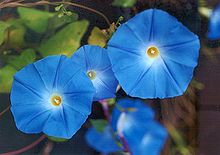- Ipomoea tricolor
-
- "Mexican Morning Glory" redirects here. This can also refer to the red-flowered I. coccinea.
Ipomoea tricolor 
Ipomoea tricolor 'Heavenly Blue' Scientific classification Kingdom: Plantae (unranked): Angiosperms (unranked): Eudicots (unranked): Asterids Order: Solanales Family: Convolvulaceae Genus: Ipomoea Species: I. tricolor Binomial name Ipomoea tricolor
Cav.Ipomoea tricolor is a species of morning glory native to the New World tropics, and widely cultivated and naturalised elsewhere. It is a herbaceous annual or perennial twining liana growing to 2-4 m tall. The leaves are spirally arranged, 3-7 cm long with a 1.5-6 cm long petiole. The flowers are trumpet-shaped, 4-9 cm diameter, most commonly blue with a white to golden yellow centre.
Contents
Cultivation and uses
In cultivation, the species is very commonly grown mis-named as Ipomoea violacea, actually a different though related species.
Horticulture
Numerous cultivars of I. tricolor with different flower colours have been selected for use as ornamental plants; widely-grown examples include Blue Star, Flying Saucers, Heavenly Blue, Heavenly Blue Improved, Pearly Gates, Rainbow Flash, Skylark, Summer Skies and Wedding Bells.
Some people consider this plant to be an invasive weed due to its fast rate of growth and its prodigious seed production.
Entheogenic use
The seeds, vines, flowers, and leaves contain ergoline alkaloids, and have been used for centuries by many Mexican Native American cultures as an entheogen; they were known to the Aztecs as tlitliltzin, the Nahuatl word for "black" with a reverential suffix. In South America, the seeds are also known as badoh negro.
Richard Schultes in 1941 described Mexican Native American use in a short report documenting the use dating back to Aztec times cited in TiHKAL by Alexander Shulgin. Further research was published in 1960, when Don Thomes MacDougall reported that the seeds of Ipomoea tricolor were used as sacraments by certain Zapotecs, sometimes in conjunction with the seeds of Rivea corymbosa, another species which has a similar chemical composition, with lysergol instead of ergometrine. This more widespread knowledge has led to a rise in entheogenic use by people other than Native Americans.
The hallucinogenic properties of the seeds are usually attributed to ergine (also known as d-lysergic acid amide, or LSA), although the validity of the attribution remains disputed. While ergine is listed as a Schedule III substance in the United States, parts of the plant itself are not controlled, and seeds and plants are still sold by many nurseries and garden suppliers.
The seeds also contain glycosides, which may cause nausea if consumed.
External links
Ergolines Lysergic acid derivatives 2-Bromo-LSD (BOL-148) • Bromocriptine • Cabergoline • Dihydroergocornine • Dihydroergocristine • Dihydroergocryptine • Dihydroergometrine (Dihydroergonovine, Dihydroergobasine) • Dihydroergotamine • Dihydroergotoxine • Ergine (LSA; LA-111; Lysergamide) • Ergocornine • Ergocristine • Ergocryptine • Ergoloid • Ergometrine (Ergonovine, Ergobasine) • Ergometrinine • Ergotamine • Ergotoxine • Ergovaline • Lisuride • LSD • LSH • Lysergic Acid • Lysergic acid cyclobutylamide • Lysergic acid cyclopentylamide • Lysergic Acid Methyl Ester • Lysergol • Mesulergine • Metergoline • Methergine (Methylergometrine, Methylergonovine, Methylergobasine) • Methysergide • Pergolide • SyntometrinePsychedelic lysergamides AL-LAD • ALD-52 • BU-LAD • CYP-LAD • DAL • DAM-57 • Ergonovine • ETH-LAD • IP-LAD • LAE-32 • LSD • LPD-824 • LSM-775 • LSH • LSD-Pip • Lysergic Acid 2-Butylamide • Lysergic Acid 2,4-Dimethylazetidide • Lysergic Acid 3-Pentylamide • Methylergonovine • Methylisopropyllysergamide • MLD-41 • PARGY-LAD • PRO-LADOther ergolines Natural sources Achnatherum robustum (Sleepy Grass) • Argyreia nervosa (Hawaiian Baby Woodrose) • Claviceps spp. (Ergot) • Ipomoea spp. (Morning Glory, Tlitliltzin, Badoh Negro) • Rivea corymbosa (Coaxihuitl, Ololiúqui)Categories:- Entheogens
- Ipomoea
- Herbal and fungal hallucinogens
- Natural sources of lysergamides
Wikimedia Foundation. 2010.


